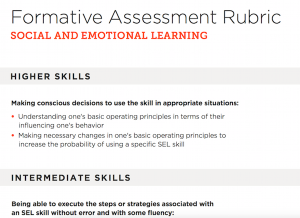Building SEL Skills Through Formative Assessment
Measure and evaluate your students’ SEL development by using a Progression Chart and strategies that include probing discussions, unobtrusive assessments, and student-generated assessments.
Your content has been saved!
Go to My Saved Content.Editor's note: This piece by Robert J. Marzano is adapted from "Using Formative Assessment with SEL Skills" in Handbook of Social and Emotional Learning: Research and Practice, now available from Guilford Press.
Formative assessment has been established as one of the mainstay classroom strategies for enhancing student learning. Unlike summative assessment, which is typically given at the end of a lesson unit or year (for example, with a final exam or course grade), formative assessment is used throughout a lesson to help educators adjust their instruction to meet student needs. As Heritage (2008) explains, "The purpose of formative assessment is to provide feedback to teachers and students during the course of learning about the gap between students' current and desired performance so that action can be taken to close the gap."
Formative assessment owes much of its current popularity to Black and Wiliam's (1998) conclusion that it is potentially one of a classroom educator's most powerful tools to enhance student learning. However, a more recent analysis by Kingston and Nash (2011) shed some doubt on this claim, pointing out that it can be implemented in many different ways, from short question-answer activities to long, formal tests. While some types of assessments were effective (such as providing feedback), others had limited effectiveness in classrooms.
What Does the Social and Emotional Learning Practitioner Do?
Social and emotional learning (SEL) helps students develop skills that provide a foundation for being a good student, citizen, and worker (CASEL, 2013):
- Self-awareness: accurately recognizing one's emotions and thoughts, and their influence on behavior
- Self-management: regulating thoughts, emotions, and behaviors in different situations and being able to set and achieve personal and academic goals
- Social awareness: taking the perspective of and empathizing with others from diverse backgrounds
- Relationship skills: establishing and maintaining constructive relationships with diverse individuals and groups
- Responsible decision making: making ethical and respectful choices about personal behavior and social interactions
SEL practitioners can help develop skills in every type of school and in students of every background through systematically teaching, modeling, and facilitating students' application of these skills in daily life, and establishing caring and highly engaging classroom and schoolwide learning environments. More than two decades of research document that well-designed, effectively implemented SEL programs enhance students' social and emotional skills, self-esteem, bonding to school, classroom behavior, and academic achievement; and reduce disruptive classroom behavior, aggression, bullying, and substance use (Durlak et al., 2011; Greenberg et al., 2003; Sklad, Dieskstra, De Ritter, Ben, & Gravesteijn, 2012; Zins et al., 2004).
Given these positive findings, another reasonable question that a practitioner might ask is, "What am I supposed to do regarding formative assessment and SEL?" Despite the ambiguous findings to date, which are largely due to the varied ways that formative assessment can be used, looking specifically at feedback can be helpful. Hattie and Timperley (2007) synthesized the research on feedback and developed an effective model that focused on establishing clear learning goals, tracking student progress toward those goals, and helping students identify their possible next steps to attain those goals.
Setting Goals for Social and Emotional Learning
A chart (see image below) can be used to help students progress from low-level SEL skills (such as simply knowing what’s important), to mid-level skills (being able to execute the steps or strategies associated with SEL), to high-level skills (making conscious decisions to use the skill in appropriate situations).

The progression depicted in this chart allows for tracking a student's progress and nicely fits the criteria for formative assessment suggested by the research on feedback. That is, it provides a clear goal -- in this case, the ability to execute the SEL skill at the top level. It allows students to track their progress over time. Additionally, it provides guidance as to the next steps that students must take. For example, if a student understands the declarative knowledge appropriate to the SEL skill, the next step would be to start practicing and shaping the skill.
Using the SEL progression chart, score values of 0, 1, 2, 3, and 4 can be associated with a student’s progress:
Score 4
The student makes conscious decisions to use SEL skills in appropriate situations. For example:
- Understanding how one's own beliefs might stop him or her from expressing an understanding of those who have different opinions
- Being able to make revisions in one's own beliefs
Score 3
The student is able to execute the steps or strategies associated with SEL skills without error and with some fluency. For example:
- Acknowledging the opinions of others, even if different from one's own
- Actively listening to others
- When making a point that is counter to someone else's opinion, focusing on the logic of the point
Score 2
The student understands the declarative knowledge important to an SEL skill and is able to explain or describe what an SEL skill is. For example:
- Understanding, in general terms, that SEL skills (such as acknowledging the opinions of others or listening actively) exist
- Knowing the meaning of basic terms such as opinion, disagreement, conflict, confrontation, and respect
Score 1
The student has partial success at achieving SEL skill proficiency at score 2 or 3, but needs help.
Score 0
Even with help, the student has no success at achieving SEL skill proficiency.
Partial scores, such as 2.5 or 3.5, can be given for proficiency at a certain level and partial proficiency at the next level.
Editor’s note: The SEL Progression Chart is adapted from the Marzano Scale adapted for SEL skills, which can be found in chapter 22 of the Handbook of Social and Emotional Learning.
3 Assessments to Build SEL Skills
To help students develop their SEL skills, teachers can use the following assessment strategies:
Probing Discussions
When using a probing discussion, a teacher meets with an individual student and asks him or her questions about the SEL skill, making sure to address the score 2 content, the score 3 content, and the score 4 content. In this scenario, the teacher has the flexibility to continue asking questions until he or she is reasonably confident about the student’s level of proficiency. For example, if the teacher determines that the student has demonstrated adequate understanding of the simpler content (i.e., score 2 content) and demonstrated partial understanding of the score 3 content, the student is assigned a score of 2.5.
Unobtrusive Assessments
With an unobtrusive assessment, a student might not even be aware that he or she has been assessed. For example, assume that a teacher observes one student interacting with another student regarding a topic about which they disagree. The teacher notices that the first student is trying to use strategies specific to the skill of expressing understanding of those who hold different opinions, which indicates score 3 behavior. However, the student is making some errors or omissions in the execution of those strategies. The teacher would assign a score of 2.5 for that student at that point in time.
Student-Generated Assessments
Student-generated assessments are perhaps the most powerful form of assessment when using proficiency scales. In such situations, the student approaches the teacher and proposes how he or she will exhibit a specific level of performance on the proficiency scale. For example, a student who is currently at the score 3 level for the skill of "expressing understanding of those who hold different opinions" might propose describing the specific beliefs that he or she had to adjust to begin using the skill in new situations. As evidence that he or she now operates at the score 4 level, the student might make that presentation in a video recording given to the teacher.
Guidelines and Recommendations
To implement the suggestions presented here, a teacher must begin by unpacking SEL standards with an eye toward identifying the explicit or implicit skill. Next, the teacher translates the skill into a learning progression like the examples shown in the SEL Progression Chart (see above image).
Scales should be presented to students and translated into "student-friendly" language. This is best done by asking students to work in small groups and translate the score 2, 3, and 4 content into familiar, readily-understood language and examples. Students should then have ample opportunity to practice their SEL skills using highly structured and teacher-directed scenarios, eventually progressing to more open-ended opportunities. For score 4 content, students can record insights about their beliefs that may inhibit their use of SEL skills, using a journal that they share only with the teacher. This allows them to be candid about their self-discovery and interact privately with the teacher through the journals.
Having students track their progress on specific SEL skills using charts or bar graphs is a very powerful and motivational tool. Each level of advancement on the proficiency scale is an opportunity for positive interaction between teacher and student. Advancement on the scale should always be acknowledged and celebrated.
Finally, the more that student-generated assessments are used to demonstrate competence at different levels of the scale, the better. These assessments put students in charge of their own success and afford them control over how they will demonstrate competence. By definition, such deliberations make students think deeply about a particular SEL skill.
Potential Problems and Pitfalls
A common tendency when teaching and assessing SEL skills is to treat them lightly, without producing actual changes in students' skills or behaviors. Using formative assessment activities can help safeguard against this tendency.
Mastering an SEL skill represents one of the more significant challenges that students face in their PreK-12 careers, in no small part due to the complex relationship between young people's self-awareness, self-efficacy, motivations, and beliefs about themselves, their peers, and the world around them. This cannot be done in a cavalier manner. Students should have a firm grounding in the fact that their behavior is greatly influenced by their beliefs and goals, and that they have the power to enhance their own lives and the lives of those with whom they come into contact.
Perhaps this is the ultimate goal of teaching and assessing SEL skills -- providing students with an understanding of why humans make decisions, and the power to make decisions based on well-reasoned beliefs as opposed to beliefs inherited from their past or their immediate surroundings.
Notes
- Black, P. & Wiliam, D. (1998). "Assessment and classroom learning." Assessment in Education, 5(1), pp.7-74.
- Collaborative for Academic, Social, and Emotional Learning (2013). 2013 CASEL Guide: Effective social, and emotional learning programs - Preschool and elementary school edition. Chicago: Author.
- Durlak, J.A., Weissberg, R.P., Dymnicki, A.B., Taylor, R.D., & Schellinger, K.B. (2011). "The impact of enhancing students' social and emotional learning: A meta‐analysis of school‐based universal interventions." Child Development, 82(1), pp.405-432.
- Greenberg, M.T., Weissberg, R.P., O'Brien, M.U., Zins, J.E., Fredericks, L., Resnik, H., & Elias, M.J. (2003). "Enhancing school-based prevention and youth development through coordinated social, emotional, and academic learning." American Psychologist, 58(6-7), p.466.
- Hattie, J. & Timperley, H. (2007). "The power of feedback." Review of Educational Research, 77(1), pp.81-112.
- Heritage, M. (2008). Learning progressions: Supporting instruction and formative assessment. Washington, DC: Council of Chief State School Officers.
- Kingston, N. & Nash, B. (2011). "Formative assessment: A meta‐analysis and a call for research." Educational Measurement: Issues and Practice, 30(4), pp.28-37.
- Sklad, M., Diekstra, R., Ritter, M.D., Ben, J., & Gravesteijn, C. (2012). "Effectiveness of school‐based universal social, emotional, and behavioral programs: Do they enhance students' development in the area of skill, behavior, and adjustment?" Psychology in the Schools, 49(9), pp.892-909.
- Zins, J.E., Weissberg, R.P., Wang, M.C., & Walberg, H.J. (Eds.) (2004). Building academic success on social and emotional learning: What does the research say? New York: Teachers College Press.
